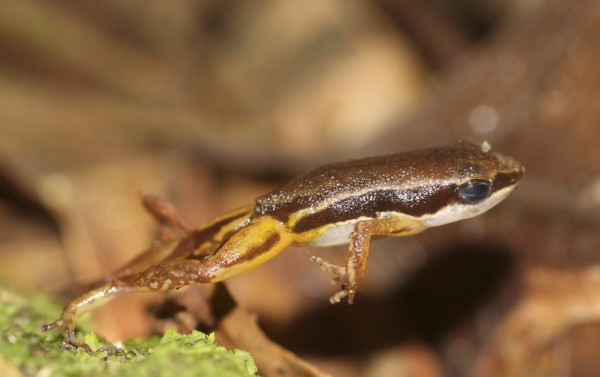
Frogs, including this Silverstoneia flotator, have all sorts of fascinating adaptations that can give them a “competitive” edge in the wild. (Photo by Brian Gratwicke, Smithsonian Conservation Biology Institute)
On July 27, 2012, the 30th Summer Olympiad opened in London. Thousands of the best athletes from almost 200 countries are competing against one another in friendly competition for two weeks. Billions around the world have tuned in to watch the sporting events.
Few people, however, tune in to the competition going on outside their own window. For a frog, winning the 100 meter dash to a hiding place isn’t a gold medal win. It’s a win for survival. As many athletes mention, there is no second place, unless the belly of a bird counts.
As natural selection demands, only the best survive. With the Olympics in full swing, it’s a good time to take a look at the best of the best in the frog world. What follows is a list of a few of those that live by the Olympic motto, “Faster. Higher. Stronger.”
1) Longest jump – The longest recorded jump by a frog (not to be confused with the human frog jump!) was completed by a frog called Santjie at a South African frog derby. The frog, of unknown species, jumped an astounding 33 feet, 5.5 inches. In the United States, the record holder at the famous Calaveras County Jumping Frog Jubilee is Rosie the Ribeter (American bullfrog, Rana catesbeiana), who jumped 21 feet, 5.75 inches in 1986. According to the rules, the leaps were the total measure of three jumps.
2) Weightlifting – Some of the largest athletes at the Olympics are the weightlifters. With the top weight class clocking in at more than 230 pounds and able to lift twice that, these competitors have some massive muscles. The largest frog, and by proxy probably the strongest, is the goliath frog (Conraua goliath). This behemoth, found in a narrow range of Equitorial Guinea and Cameroon, clocks in at 1 foot long and more than 7 pounds! They are listed as endangered by the IUCN because of overharvesting for frog legs.
3) Wrestling – While the single largest individuals at the Olympics have often been wrestlers, the champions of the frog world are much, much smaller. Many frogs will tustle over territory during mating season, but the tiny members of the family Dendrobatidae are the best known for it. You can watch a fantastic clip of a 30-minute wrestling match from David Attenborough’s Life in Cold Blood on YouTube. The frogs rumble and tumble for up to half and hour, with the winner keeping the prime territory and the adoration of the ladies.
4) Gymnastics – It wouldn’t be the Summer Olympics without high-flying gymnastics! In the frog world, this title would most likely belong to the flying frogs, which have independently evolved in three different genera. The most famous and one of the largest is Wallace’s flying frog (Rhacophorus nigropalmatus). All flying frogs have large, webbed feet and skin flaps that allow them to glide from the treetops to escape predators, catch food or head to the ground for mating. I’d like to see them go up against the USA’s Fab Five. Wouldn’t that be a match to see?
Though there are many other frogs out there, I hear the closing ceremonies beginning. Unless that bird catches up, see you again in four more years!
–– Andrew Franks, Zoo New England



